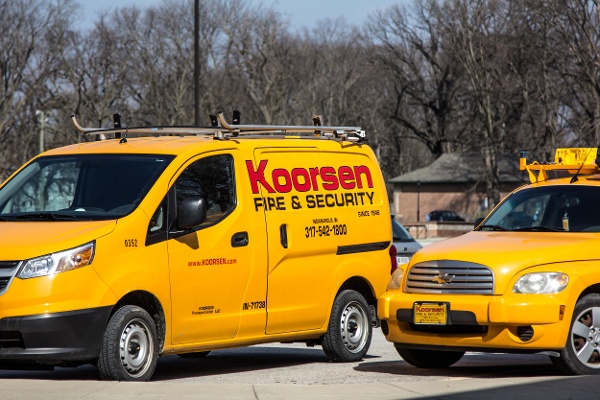
Koorsen Fire Alarm Inspection
Ever wonder what is involved when a Koorsen technician performs an inspection of a building’s fire alarm systems? Well, today is your lucky day. Follow along with a team of Koorsen technicians as they perform fire alarm inspections at a school campus in Indianapolis, Indiana.
Alert the Authorities
As the sun begins to rise on a sunny spring day in Indianapolis, one of the Koorsen Systems Inspection Technicians contacts the monitoring station and the fire department to inform them that Koorsen will be inspecting and testing the fire alarms at a 76-acre, multiple building school campus located on the eastside of Indianapolis. This is obviously a very important step because as the fire alarms are tested, you do not want the fire departments to waste their resources on the false alarms.
It Takes Two to Inspect
Once the authorities have been notified that inspections and testing will be taking place, the technicians grab their tools and enter one of the many buildings on the campus to inspect. Today is the last day of inspections for this school. There have been multiple teams at this campus for the past week and a half that have been inspecting and testing the fire alarms in several buildings.
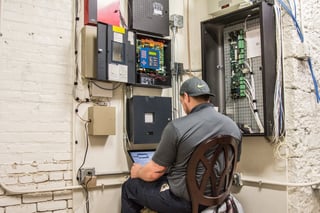
To inspect and test the fire alarms, it takes a team of two technicians. The first technician is stationed at the fire alarm panel, while the second technician goes from floor to floor inspecting and testing the smoke detectors, fire alarm pull stations, and the fire alarm horns & strobes. The technician at the fire panel checks to see that the fire alarm panel is activated when a smoke detector or fire alarm pull station is activated.
Start at the Top
In this older building, the first technician is stationed at the fire alarm panel located in the basement, while the second heads up to the attic to start inspecting and testing the fire alarm components. The technician heading to the attic states that it’s good to always start at the top of buildings and work your way down, ensuring that every smoke alarm and pull station is tested. The technician climbs an old narrow stairs and arrives in the attic where it is warm but not unbearable, as it is just the end of March.
Inspecting & Testing the Smoke Detectors
To test a smoke detector, the Koorsen technician uses a special tool that looks like a cup on the end of a pole. At the bottom of the cup is an aerosol can that contains a spray that imitates smoke and will cause the smoke detector to activate. The cup is placed over the smoke detector and the technician applies a little pressure that causes the aerosol can to spray a tiny amount of “fake smoke”. In about five seconds, the smoke detector detects the smoke and activates, which causes the fire panel to go off.
There is also an alternative method that Koorsen technicians use to test smoke detectors that doesn't require a pole. This method uses an aerosol can with an extendable funnel on it to direct the "fake smoke" towards the smoke detector.
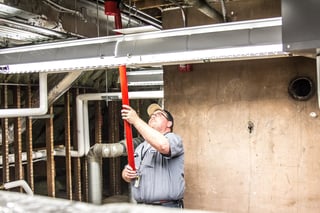
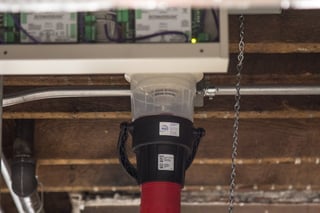
At the fire panel, the other technician checks to see that the smoke detector was activated and that it has identified with the proper location. Ensuring the detector’s location is identified correctly is essential, as firefighters and first responders will know exactly where the fire is located in the building when they arrive. The technician in the attic then moves on and checks each and every smoke detector on the floor. Sometimes it seems as if the smoke detectors are playing hide and seek, as the technician bends and twists around ducts and piping and low ceilings to search for “hidden” smoke detectors.
Inspecting & Testing the Fire Alarm Pull Stations
The next thing the technician checks before moving on to the next floor are the fire alarm pull stations. You may be familiar with pull stations from grade school when a defiant kid would pull the alarm, causing the entire school to evacuate the building. This usually seemed to happen during the coldest or hottest day of the year. The technician informs us that many of the school systems put blue dye on the pull handles, which makes it easy to identify the culprit of false alarms.
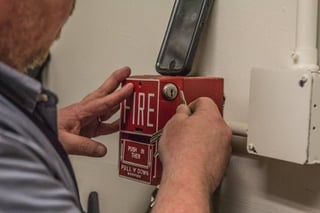
To test the fire alarm pull stations, the technician pulls the handle to activate the pull station. At the fire alarm panel, the other technician sees the notification that the pull station was activated and relays that information back to the other technician. With a key, the technician is then able to reset the pull station. When testing the pull stations at this time, the fire alarm horns and strobes have been deactivated as to not disturb any occupants in the building. Later on, the technicians will test the horns and strobes to ensure they are working on all floors.
On to the Next Floor
After inspecting and testing the fire sprinkler components, the smoke detectors, and the pull stations; the Koorsen technician moves onto the next floor. The same inspection and testing process is performed at every floor until he finally reaches the basement where the fire panel is located. Once in the basement, the technician performs the same inspections and testing until every smoke detector and pull station are accounted for.
Bring the Noise – Testing the Fire Alarm Horns & Strobes
One of the last steps is to test the fire alarm horns and strobes. To do this, the technician at the fire alarm panel first activates the horns and strobes and then the other technician pulls a handle on one of the fire alarm pull stations to cause them to go off. Before they do this however, they go from floor to floor to inform any occupants that they will be turning on the fire alarm horns and strobes for a short period of time. Once everyone has been notified, one of the technicians activates the fire alarm horns and strobes from one of the pull stations and both technicians walk each floor to check that every horn and strobe is working. They both meet back at the fire alarm panel and turn off the horns and strobes.
Checking the Batteries
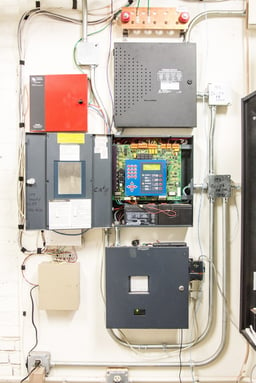
One of the last and final steps of an inspection is to test the fire alarm panel’s battery backup. Inside the fire alarm panel, you will find a couple of battery packs that provide power to the fire alarm control panel in the event of a power outage. The batteries are tested to ensure they are sufficient. If the batteries fail, then they are replaced. The batteries are also tested in the notification appliance circuits (NAC) panel which is part of the fire alarm system and located beside the fire alarm panel. The NAC is what helps power and connect the detectors, strobes, horns, and fire alarm components to the fire alarm panel.
Fire Alarm Inspection Complete
As you can see, there are a lot of steps that go into inspecting the fire alarm system of a building. Each step is critical in order to ensure the entire fire alarm system works flawlessly in the event of a fire.
To learn more about the services, inspections and products Koorsen Fire & Security offers or to schedule an inspection, contact a Koorsen associate today.


